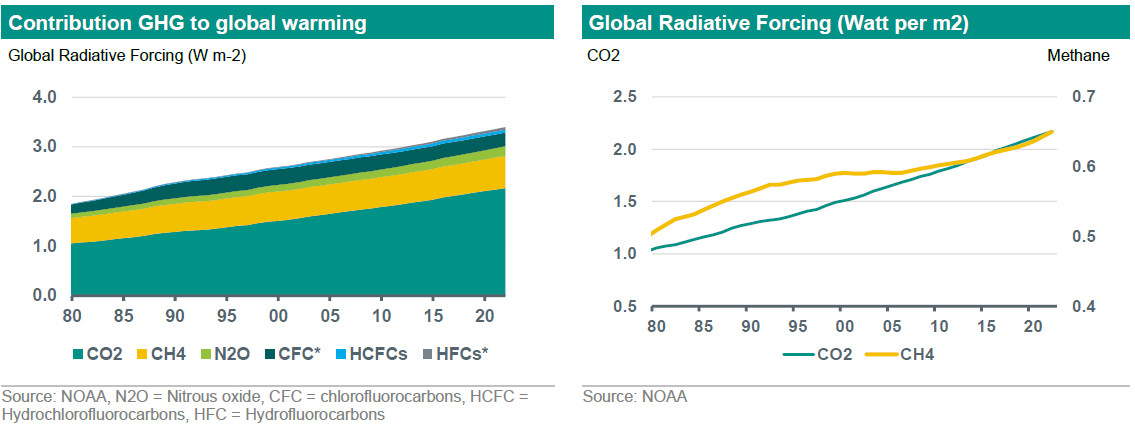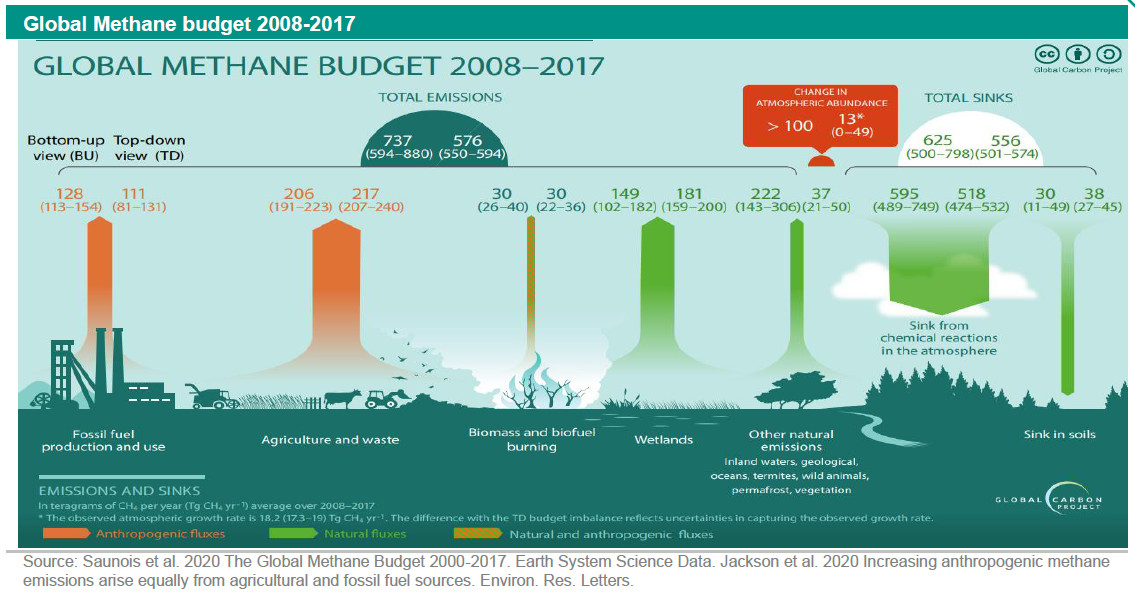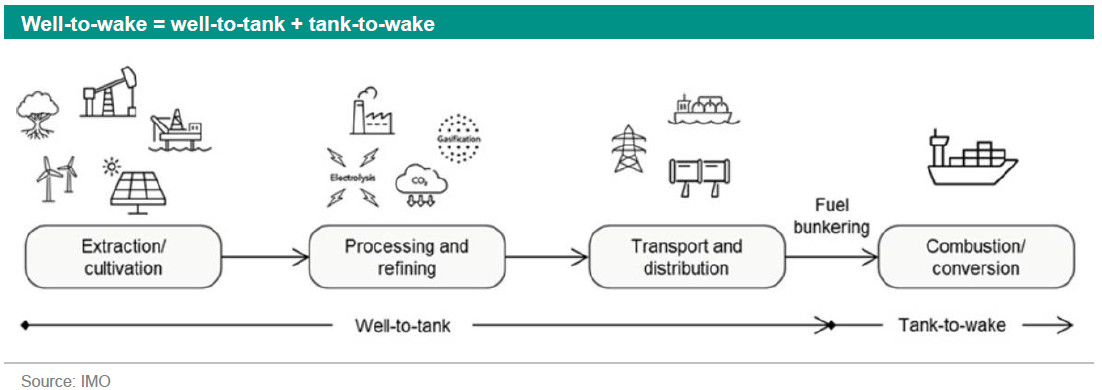ESG Economist - LNG is not the holy grail for shipping

In the aim of limiting global warming to 1.5 degrees, the shipping industry has an important role to play. Shipping carries close to 80-90% of global trade and accounts for 2-3% of global greenhouse gas (GHG) emissions annually. Shipping is a capital-intensive industry characterized by large, long-life assets (vessels and bunkering infrastructure 20-30 years), thin margins and a high-dependence on a global supply of energy-dense fuels. Achieving significant reductions in emissions of international maritime transport requires using both less energy (increasing energy efficiency) and cleaner types of energy (using renewable and low-carbon fuels). Increasing efficiency and optimising operations come first. These are the low hanging fruit. After all these types of measures are applied, the only way forward is changing the fuel. The main proportion of energy consumption in international shipping relates to propulsion of the vessel at steady speed over long distances. Vessels mainly have internal combustion engines that use marine fuel oils. The shipping industry is moving towards LNG as (transition) energy carrier because it produces considerably lower CO2 emissions. However, there are also disadvantages to using LNG, the main being the methane slippage. In this report we start with methane as a greenhouse gas and show its share in total greenhouse gas emissions. Then we show what sectors are responsible for the methane in the atmosphere and what is maritime shipping’s role in this. This is followed by an overview of the regulatory landscape and what can be done to reduce methane emissions.
International shipping is responsible for 2-3% of global greenhouse gas emissions
Changing the energy carrier is the only way to reduce emissions after implementing all possible efficiency and optimization measures
However, the ideal energy carrier for the future has not been defined yet
To meet at least some of the reduction targets, part of the sector is switching to LNG from marine fuel oil
LNG substantially lowers sulphur, nitrogen oxides, CO2 and particulate matter emissions, but it also has one major drawback: LNG mostly consists of methane
In marine engines part of this methane is not burnt and escapes into the atmosphere
Methane is a far more harmful greenhouse gas than CO2
In coming years regulations on methane emissions will become stricter reducing the attractiveness of LNG as energy carrier unless methane leaks and methane slip are reduced to negligible levels
What is methane?
In sustainability strategies, CO2 gets the most attention because it makes the largest contribution to climate change. However, the importance of the impact of other green house gasses should not be underestimated, for example, methane (CH4). The impact of the different greenhouse gasses on the temperature increase is dependent on three variables. First, how much of a greenhouse gas is emitted. Second, how long does the greenhouse gas remain in the atmosphere. Second, how much energy does the greenhouse gas absorb. Methane has a much shorter atmospheric lifetime than carbon dioxide (CO2) around 7-11 years compared to centuries for CO2. However methane absorbs much more energy while it exists in the atmosphere than CO2. This is measured by radiative forcing. Radiative forcing measures how much energy from the sun enters the earth’s atmosphere compared to how much exits as heat. This is calculated in watts per square meter. CO2 is by far the largest contributor to total radiative forcing and methane is the second largest contributor. Methane remains for a shorter time in the atmosphere but on a molecular level, methane is more powerful than carbon dioxide. Moreover, methane has a significant effect on the climate and contributes to tropospheric ozone formation, a potent local air pollutant, which itself causes serious health problems (see more ). It also leads to the production of water vapor in the stratosphere by chemical reactions, enhancing global warming (see more ). Methane has a global warming potential (GWP) 29.8 times compared to that of carbon dioxide (CO2) over a 100-year timeframe. So, methane comes only second to carbon dioxide in its overall contribution to climate change. The graphs below show the contribution of the major greenhouse gasses to global warming over the years.

According National Oceanic and Atmospheric Administration or NOAA, the concentration of methane in the atmosphere is 1.933,46 parts per billion (October 2023) up from 1.920,16 a year earlier. 1 ppb indicates that one out of every billion molecules in an air sample is methane. The Global Methane Budget suggests that annual global methane emissions are around 580 Mt. This includes emissions from natural sources (around 40% of the total) and from human activity (around 60% of the total), also known as anthropogenic emissions. The methane budget is the budget of all emissions and removals of methane. Unlike for carbon dioxide for which only half of human emissions are removed by uptake in natural reservoirs, for methane, about 97% of annual emissions are offset by removals within the atmosphere from reaction with OH (hydroxyl) radicals, which are formed by several natural processes. Thus, the growth rate of methane is the subtle imbalance between emissions and absorption by a huge natural OH sink (see graph below).
The largest anthropogenic source for methane is agriculture (livestock and rice paddies), responsible for around one quarter of emissions, closely followed by the energy sector, which includes emissions from coal, oil, natural gas and biofuels. The amount of methane that leaks during the fossil production process, transportation and storage varies depending on the production facilities and the gas treatment processes. Methane leakages can occur because of material deficiencies, or through venting or flaring. The graph below shows the contribution per sector. According to the IEA, methane emissions from the global energy sector rose to 135 Mt in 2022; natural gas was responsible for 36 Mt of methane emissions.
The graph below misses an increasingly important source of methane emissions though, namely the use of LNG as energy carrier for maritime shipping and the methane slip.

LNG as energy carrier in shipping
Liquified Natural Gas (LNG) is the cleanest fossil energy source, which compared to heavy fuel oil, could reduce sulphur emissions by 99%, nitrogen oxides by 80%, and CO2 emissions by up to 20%, along with most particulate matters (see more ). It is often seen as the transition fuel. But there are also disadvantages. First the energy density of LNG is lower than marine fuel oil so LNG tanks take up more space on the vessel. The major disadvantage of LNG that it consists primarily of methane (85-95%) and there is a methane slip (more on this below). Other sectors also use LNG, but maritime shipping has not currently have a better alternative to switch the energy carrier while other sectors do.
The world fleet in 2022 was 1,606 million gross tonnes and 109,019 vessels. Gross tonnage represents the total internal volume of cargo vessels. 1 GT is equal to 100 cubic feet or around 2.83 cubic meters. Of the total fleet, LNG fuelled vessels (mainly dual fuel) only represent 5.5% in terms of GT and around 1% in terms of number of vessels. However, the order book shows a sharp increase in LNG fuelled ships (mainly dual fuel). Around 36% of the GT ordered are LNG fuelled and in terms of vessels this is 15% (see table below). Dual fuel engines allow ships to be operated on either LLNG or conventional liquid marine fuels.

Methane slip
If a vessel’s internal combustion engines burn LNG as a fuel, most of the methane will be used up in the energy conversion process. However, some of the methane remains unburned and escapes into the atmosphere. This is known as the methane slip. It results directly from the performance of the engine itself. Either by leakage through piston rings, or because of insufficient combustion. Methane slip occurs when unburned gas is emitted from the engine. Certain engine types are undoubtedly better at controlling methane slip than others.
Two-stroke diesel engines and gas turbines produce minimal amounts of slip, particularly when compared with Otto cycle four-stroke engines operating in highly transient conditions. On a four-stroke engine, Otto cycle means that gas and air are mixed before the charge enters the cylinder. Then this more-or-less homogenous mixture is compressed in the combustion chamber and ignited with a small pilot flame (see more ). Otto-cycle gas combustion is characterized by a natural trade-off between methane slip and NOx emissions.
Two stroke engines are best used where space can present a constraint and noise is not an issue. The most popular engine for LNG-powered cruise ships and ferries is a four-stroke engine that has the highest methane slippage. It is the engine favoured by cruise ships and ferries, because of space and noise considerations as well as flexibility given changing power load. It is also used by 40% of LNG carriers and is often used as an auxiliary engine.
How large are methane emissions from shipping?
A study (see more ) finds that that real-world methane slip measured in the plumes of 18 ships using the most common type of LNG marine engine (LPDF 4-stroke) averaged 6.4%, whereas EU regulations assume 3.1% methane slip and the United Nations International Maritime Organization (IMO) assumes 3.5%. Methane slip calculated from 22 measurements of 18 unique ships that exclusively used these types of engines averaged 6.42% with a median of 6.05%. For six measurements at or above 50% combined engine load, the average was 6.07% and the median was 6.59%. So according to this study, methane slip of vessels is double the EU and IMO estimates.
Regulation on methane
COP Global Methane Pledge
The Global Methane Pledge was launched at COP26 (November 2021) by the European Union and the US. Participants joining the Pledge agree to take voluntary actions to contribute to a collective effort to reduce global methane emissions by at least 30 percent from 2020 levels by 2030. This is a global, not a national reduction target. Over 150 countries have now signed the Global Methane Pledge. At COP28 some 50 oil and gas firms have signed an agreement to reduce their carbon emissions to net zero by 2050 and curb methane emissions to net zero by 2030.
EU
Since January 2024 the EU Emission Trading System (ETS) has been extended to all ships of 5,000 gross tonnage and enter the EU ports. The system covers: 50% of emissions from voyages starting or ending outside of the EU (allowing the third country to decide on appropriate action for the remaining share of emissions); 100% of emissions that occur between two EU ports and when ships are within EU ports. This means that ship owners must pay for their GHG emissions when transporting to, from or between EU ports. EU ETS is based on tank-to-wake (TtW) emissions and will initially only cover CO2 emissions. However, from 2026 methane and nitrous oxide emissions will also be included. To ensure a smooth transition, shipping companies only have to surrender allowances for a portion of their emissions during an initial phase-in period: 2025: for 40% of their emissions reported in 2024; 2026: for 70% of their emissions reported in 2025; 2027 onwards: for 100% of their reported emissions. The graph below shows the difference between tank-to-wake and well-to-wake.
Additionally, in January 2025 FuelEU Maritime, which aims to promote the use of renewable and low-carbon fuels, will come into force. Non-compliance with the regulations will have a direct financial impact for ship owners. FuelEU Maritime tightens requirements on well-to-wake (WtW) GHG intensity limits for fuel consumed on board compared to the 2020 reference limit – and methane emissions are included from day one.
UN International Maritime Organization Strategy update July 2023 (see more here)
The International Maritime Organization (IMO) is the UN specialized agency responsible for the safety and security of shipping and the prevention of marine and atmospheric pollution by ships. On 7 July 2023, it revised its strategy on reduction of greenhouse gas emissions from ships. The strategy identifies levels of ambition for the international shipping sector noting that technical innovation and the global introduction and availability of zero or near-zero GHG emission technologies, fuels and/or energy sources for international shipping will be integral part to achieving the overall level of ambition. The levels of ambition and indicative checkpoints should take into account the well-to-wake GHG emissions (also including methane) of marine fuels as addressed in the guidelines on lifecycle GHG intensity of marine fuels (LCA guidelines).

The regulations will be mandatory for all ships. Vessels will not get any exceptions based on the flag they are registered under. The lifecycle assessment method refers to the assessment of greenhouse gas emissions from the fuel production to the end-use by a ship or well-to-wake approach; it results from the combination of a well-to-tank part (from primary production to carriage of the fuel in a ship's tank, also known as upstream emissions) and a tank-to-wake (or tank-to-propeller) part (from the ship's fuel tank to the exhaust, also known as downstream emissions). The graph above is the visual overview of the approach.
LNG versus diesel/oil
Marine fuel produces more CO2 and LNG produces less CO2, sulphur, nitrogen oxides emissions and particulate matters, but leads to methane emissions. This leads to the question of what fuel is better in terms of impact on global warming? To answer this question we take into account the emission factors of the different fuels in the IMO initial strategy and the IMO revised strategy. The IMO initial strategy was based on tank-to-wake emission factors for the different marine fuels. LNG had a lower emission factor than diesel/oil and most other fossil fuels (except methanol and ethanol). But taking into account the new well-to-wake emission factors of the revised strategy (July 2023) LNG is above diesel/oil. If the different types of engines are considered for the emission factors, in the best case scenario the emission factor for LNG is only a bit better than diesel/oil. To decide what fuel is better in terms of global warming impact it really depends on the vessel type, operating region and age of the vessel. If the vessel has a dual fuel engine, one should consider where it is operating. To evaluate the potential retrofit of a mono-fuel diesel vessel to run on today's LNG technology one should compare it with other efficiency measures (technological as well as operational).
How to limit methane emissions?
There are several ways to reduce man-made methane emissions such as stop the use of LNG, replace fossil LNG by renewable LNG, the removal of methane and improved engine technologies. Below we provide more details on each of the options.
Stop the use of LNG altogether?
The first solution would be to stop using LNG altogether. This will stop the leakages from the production, transporting and storage of LNG and also bring an end to the methane slip. However, LNG is used as a transition fuel in different sectors. First, in the maritime sector as it is less polluting in terms of CO2 and sulphur than other frequently used marine fuels and the decision about the future energy carriers has not been made yet. Second, LNG is also used in electricity production as it has lower emission intensity in terms of CO2 emissions than other fossil fuels and the renewable capacity and backup are not sufficiently built up yet.
Replace fossil LNG by renewable LNG?
Bio-gas is produced by the breakdown of organic matter. It is a mixture of methane, hydrogen and carbon dioxide. The methane content of biogas typically ranges from 45-74% by volume, with most of the remainder being CO2. The precise composition of bio-gas depends on the type of feedstock and the production pathways. Bio-methane is a bio-gas from which the carbon dioxide, hydrogen sulfide and water have been removed. It Is also known as renewable natural gas. As a result of the purification process, the bio-methane has the same characteristics as natural gas. So bio-methane is the purified form of natural bio-gas. There may be fewer leakages in the production, transportation and storage of bio-gas and bio-methane but methane is still the main component, meaning any leak or slip will result in more methane in the atmosphere.
Methane capturing/removal?
We have several recent publications focussed on carbon capture (see here), transportation (see here), storage (see here) and utilisation (see here). This technology is deployed on a relatively small scale. It is expensive and energy intensive. Capturing methane instead of carbon dioxide is even a bigger challenge. There are some methane capturing technologies and removal technologies, which we elaborate on below.
Capturing methane from the air - The methane concentration in the atmosphere is substantially lower than the concentration of CO2. Indeed, methane is two hundred times less abundant in the atmosphere than CO2. As methane has a higher Global Warming Potential (see above), considerably less methane removal is needed to realise the same climate impact (see more ). Capturing methane is carried out differently than capturing CO2. You can capture CO2 from the air or from flue gas because it has a chemical structure that allows you to kind of put a ‘hook’ on it, but the methane molecule does not — and so capturing methane is very, very difficult (see more ). Most methane removal technologies focus on oxidizing the greenhouse gas.
Catalysts to control methane emissions - Catalytic oxidation is a process in which the exhaust gas containing methane flows over a catalyst, usually a precious metal like palladium or platinum in the case of a methane oxidizer. The catalyst lowers the chemical activation energy thereby accelerating the process of methane reacting with oxygen to produce CO2 and H2O. Palladium-based catalysts and rhodium-based catalysts could achieve nearly 100% methane reduction for 4-stroke engines, operating at temperatures between 395°C and 530°C. However, for the exhaust temperature range of 2-stroke engines, operating between 280°C and 330°C, palladium-based catalysts and rhodium-based catalysts would be ineffective. The disadvantage of a palladium catalyst is that it is susceptible to aging and poisoning. Rhodium is resistant to aging and poisoning but is much more expensive than palladium and platinum (see more ).
Another oxidizing technology - Another method to oxidize methane that does not require a catalyst is a regenerative thermal oxidizer (RTO). Many RTOs consist of two porous heat beds connected by an oxidation chamber. In an RTO, the exhaust gas containing methane flows through the first heat bed, which acts as a preheater. Once the exhaust reaches the target temperature, the methane oxidizes and releases heat. The gas then leaves the oxidation chamber and transfers heat to the second heat bed, which acts as a heat sink.The benefit of using a regenerative thermal oxidizer is that there is no risk of aging and poisoning (see ).
There are several challenges related to methane capture/removal. First, methane is 200 times less abundant in the atmosphere than CO2. The less abundant the gas, the more the energy needed to remove it. This is especially the case with methane capture from the atmosphere. Second, methane removal technologies are heavily investigated but have generally low technical readiness levels. Third, the catalyst material needs to be sulfur-resistant and ideally not expensive.
Engine modifications
The engine manufacturer Wärtsilä has been conducting research and development on engine modifications to radically reduce methane slip including upgrading existing engines, and optimizing engine design and control. Another advanced emission control method is “skip-firing” under reduced loads to avoid higher emissions when lower amounts of fuel are injected, and combustion cannot occur under optimum conditions. Skip firing is an advanced cylinder deactivation technology where the decision to fire or skip a singular cylinder of a multi-cylinder engine is made immediately prior to each firing opportunity. The aim is to reduce fuel consumption and lower emissions.
Conclusion
International shipping is responsible for 2-3% of the global greenhouse gas emissions. To reduce emissions increasing efficiency and optimising operations come first. These are the low hanging fruit. After all these types of measures are applied, the only way forward is changing the fuel. However, the ideal energy carrier for the future has not been defined yet. As a result, to meet at least some of the reduction targets, part of the sector is switching to LNG as energy carrier. LNG substantially lowers sulphur, nitrogen oxides, CO2 and particulate matter emissions but it also has one major drawback. LNG mostly consists of methane and in marine engines part this methane is not burnt and escapes into the atmosphere. Moreover, methane is a far more powerful greenhouse gas. In the coming years regulations on methane emissions will become stricter reducing the attractiveness of LNG as energy carrier unless methane leaks and methane slips are reduced to a minimum and/or methane is removed.
